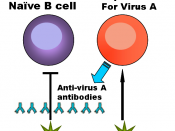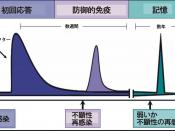The five major immunoglobulin classes are designated IgA, IgD, IgE, IgG, and IgM, on the basis of the C regions in their heavy chains. The antibodies of each class have different biological roles and locations in the body.
IgA - IgA monomer exists in limited amounts in plasma. The IgA dimer, also called secretory IgA, is found in body secretions such as saliva, sweat, intestinal juice, and milk, and helps prevent attachment of pathogens to epithelial surfaces (including mucous membranes of the epidermis). It plays a major role in preventing pathogens from gaining entry into the body.
IgD - Always bound to the external surface of a B cell, functioning as the antigen receptor of the B cell and is important in B cell activation.
IgE - IgE antibodies are almost never found in blood. They are the antibodies involved in some allergies. IgE is slightly larger than the IgG antibody. It is secreted by plasma cells in skin, mucosae of the gastrointestinal and respiratory tracts, and tonsils. Its stem region becomes bound to mast cells and basophils, and when it's receptor ends are triggered by an antigen, it causes the cells to release histamine and other chemicals that mediate inflammation and an allergic reaction. Typically only traces of IgE are found in plasma, but levels rise during severe allergic attacks or chronic parasitic infections of the gastrointestinal tract.
IgG - The most abundant and diverse antibody in plasma, accounting for 75-85% of circulating antibodies. It protects against bacteria, viruses, and toxins circulating in blood and lymph, readily fixes complement, and is the main antibody of both primary and secondary responses. It is also the only Ig class that crosses the placental barrier. Therefore, the passive immunity that a mother transfers to her fetus is from her IgG...


